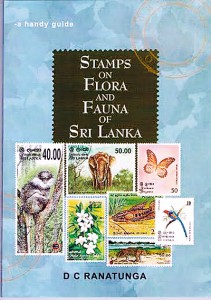Mailing our natural history and biodiversity
View(s):The first time stamps were used was in the United Kingdom in 1840, by Sir Rowland Hill. Accordingly, the world’s first adhesive postage stamp was introduced on 6th May 1840.
This was a means of addressing the problem of recovering the costs of delivering mails. Thereafter, the rest of the countries, throughout the world, including the British colonies, started issuing stamps.
Sri Lanka, then under British rule and called Ceylon, issued its first postage stamp which depicted the profile of the British Monarch Victoria, on April 1, 1857. The stamp was in the denomination of six penny, the same currency being used in England at that time.
The first postage stamp in Sri Lankan rupees was issued on February 1, 1892. On May 22, 1972 the name of the country was changed from Ceylon to Sri Lanka and a commemorative stamp was issued on that date. The Sri Lanka Philatelic Bureau, which was established in 1968, is responsible for designing and printing of stamps for use in Sri Lanka.
D.C. Ranatunga’s book ‘Stamps on Flora and Fauna of Sri Lanka’ is a very interesting and informative one. He has taken all the stamps that portray the fauna and flora of this country and sorted them into different categories. He has then developed a text that gives the reader a wider understanding of the subject on the stamp.
The texts in these categories have been written after comprehensive research into the subject. This gives an authenticity to the description. For the more discerning and scientific minded readers the author has added the scientific names of each species depicted on the stamps.
The authoritative publications of eminent persons like Sir James Emerson Tennent, C.W. Nicolas, E.F. Kelaart, W.E. Wait, G. M. Henry and others have been referred to in order to enhance the information in the text.
DCR also describes sets of stamps, of the same species, issued at the same time. For instance there are four sets of four stamps each depicting elephants. The first set of four stamps featuring wild elephants were issued in January 1936.
This was when Ceylon was a crown colony. The second set of elephant stamps was issued in August 1986 and another set of four elephants was issued in May 1998. The most recent set of four stamps was issued in July 2013.
In 1954 a set of four stamps with perahera elephants and with insets of Queen Elizabeth II, was issued to commemorate her visit to Sri Lanka. Incidentally Queen Elizabeth became the longest reigning monarch in Britain on September 10, 2015. There is also another set of four stamps, issued in 1984, in respect of the famous Dalada Perahera held in Kandy each year.
There are stamps featuring some mammals like the Leopard, Sloth Bear, Barking Deer, Wild Boar, Sambur, Slender Loris, Spotted Deer, Purple-faced Leaf Monkey, Grey Langur and Mongoose. There are also stamps featuring the marine mammals like Whales, Dolphins and Dugongs.
There are eight stamps featuring some of our freshwater fish including four endemics. Fifty birds are featured in stamps issued over the years. The Arenga and the Sri Lanka Hill Mynah are featured in two stamps issued at different times.In the first stamp issued the bird was called a Grackle but in the second it was referred to as the Sri Lanka Hill Mynah.
| Book facts ‘Stamps on Flora and Fauna of Sri Lanka’ |
Nine species of orchids are featured in stamps. Also featured are some reptile, amphibian and fish species. Then there are two sets of four stamps of different species of butterflies. One set was issued in November 1978 and the other set in December 1999.
Biodiversity is a word that has come into the environment conservation vocabulary recently. Sri Lanka’s biodiversity consists of the biological diversity of its fauna, flora and ecosystems. This book covers all the stamps depicting our fauna and flora.
However, there are no stamps that depict the different ecosystems in this country. An ecosystem is a collection of a number of species of fauna and flora, also called communities, interacting together with their abiotic (non living) environment – earth, water and air. Forests, marshes, streams, rivers, lakes, etc. are examples of ecosystems.
This is a very fascinating book. It has elements of history and natural history written into the stamps. I think everyone should buy a copy of this for a relaxed and informative read.
Incidentally, this is DCR’s second book on stamps. The first is ‘A Century of Stamps in Sri Lanka’ covering all the stamps issued during the first
100 years.


